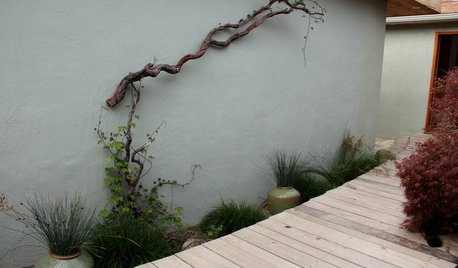Can you ID this caterpillar?
butterflymomok
14 years ago
Related Stories

GARDENING GUIDES4 Ways Gardens Can Go Beyond Aesthetic Beauty
Our landscapes can play an even more meaningful role if we rethink their purpose
Full Story
MORE ROOMSRooms I'd Like to See Wrapped Up as Gifts for the Holidays!
What Room Do You Have on Your Gift List This Year?
Full Story
HOUSEKEEPING10 Chores You Can Whip Through During Commercials
Use ad time for getting tasks done, and it’s like fast-forwarding your house into cleanliness
Full Story
DECORATING GUIDESSee How Wabi-Sabi Can Bring Harmony and Beauty to Your Home
Create your own wabi-style style with beautifully weathered, humble materials around the house
Full Story
GARDENING GUIDES3 Easy Ways You Can Garden for Nature
Your choice of plants can help wildlife while cleaning the air and water
Full Story
HOUSEKEEPINGCan-Do Cleaning Strategies for Busy People
While you dream of having a maid (to go with the cook and chauffer), this simplified cleaning routine can keep your real-world home tidy
Full Story
SMALL SPACESHow Portability Can Make You Happier at Home
Downsizing your stuff and going for maximum mobility can actually make your home feel bigger and your life feel fuller
Full Story
DIY PROJECTSMake an Upholstered Headboard You Can Change on a Whim
Classic stripes today, hot pink tomorrow. You can swap the fabric on this DIY headboard to match your room or your mood
Full Story
PETS5 Finishes Pets and Kids Can’t Destroy — and 5 to Avoid
Save your sanity and your decorating budget by choosing materials and surfaces that can stand up to abuse
Full Story
DECORATING GUIDES5 Ways Art Can Improve Your Room Design
Artwork can bring together the elements of a room by being a focal point, a color inspiration, a harmonizer and more
Full StorySponsored
More Discussions




butterflymomokOriginal Author
MissSherry
Related Discussions
Hungry caterpillars - Can anyone ID them?
Q
Can someone id this caterpillar for me please?
Q
Caterpillar ID - Big, Red Caterpillar
Q
Can you ID this caterpillar?
Q
MissSherry
butterflymomokOriginal Author
butterflymomokOriginal Author
ladobe
MissSherry
butterflymomokOriginal Author
MissSherry
todancewithwolves
butterflymomokOriginal Author
MissSherry
gcertain
ladobe
butterflymomokOriginal Author
todancewithwolves
bernergrrl
butterflymomokOriginal Author
ladobe
butterflymomokOriginal Author
ladobe
saturniidaebreeder
butterflymomokOriginal Author
ladobe
caterwallin
butterflymomokOriginal Author
MissSherry
bananasinohio
bernergrrl
butterflymomokOriginal Author
ladobe
butterflymomokOriginal Author
ladobe
bananasinohio
butterflymomokOriginal Author
bernergrrl
MissSherry
butterflymomokOriginal Author
butterflymomokOriginal Author
susanlynne48
KC Clark - Zone 2012-6a OH